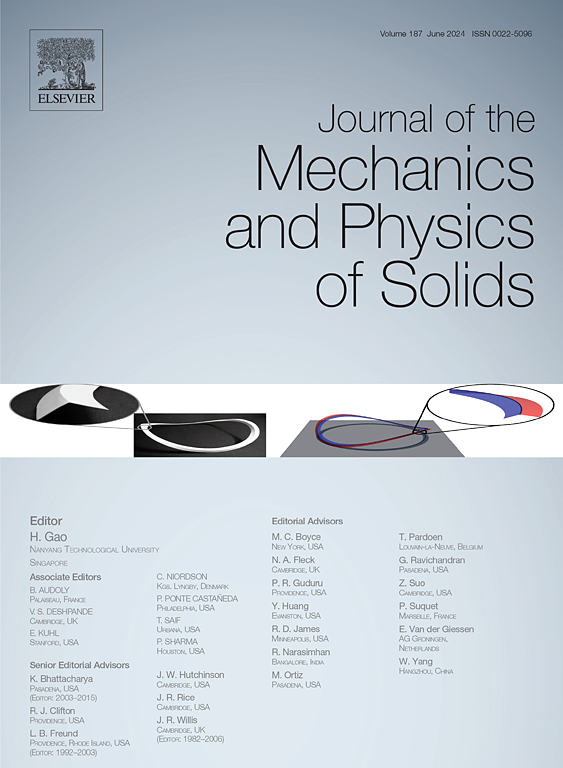从弯曲到拉伸驱动非均质胶粘剂的剥离
IF 6
2区 工程技术
Q2 MATERIALS SCIENCE, MULTIDISCIPLINARY
引用次数: 0
摘要
从理论上研究了胶粘剂的剥离行为。采用断裂力学的方法,推导了在胶粘剂与基材界面处传播的粘接锋的运动方程,并由此推断剥离强度。我们方法的独创性在于描述了在剥离过程中拉伸和弯曲变形模式之间的相互作用,这种模式被描述为Föppl-Von卡门薄膜。首先考虑直粘合面,我们检索了均匀粘合剂的最显著特征,即剥离角度依赖于剥离强度,剥离强度由大角度弯曲和低角度拉伸驱动。我们还推导出胶粘剂的形状,可以使用从我们的模型导出的单一弯曲长度尺度来描述。然后我们研究了粘附异质性的影响。结果表明,粘附面变形受非局部界面弹性控制,其强度随剥离角度的增大而减小。这种现象反映了在我们的模型中捕获的低角度拉伸主导剥离到大角度弯曲驱动剥离之间的过渡。这种转变影响了粘接前沿的稳定性,使其从扰动中松弛得更慢,并且在低剥离角度下粘接能量的无序分布会产生更强的增韧效果。总的来说,本研究揭示了胶粘剂弹性变形对其剥离行为的核心作用。提出的框架揭示了胶粘剂变形和剥离驱动力之间复杂的相互作用,可以利用这种相互作用来设计具有增强性能的异质胶粘剂。它还为界面问题中非局部弹性产生的机制提供了丰富的见解。本文章由计算机程序翻译,如有差异,请以英文原文为准。
From bending to stretching driven peeling of heterogeneous adhesives
We study theoretically the peeling behavior of adhesives. Adopting a fracture mechanics approach, we derive the equation of motion of the adhesion front propagating at the interface between the adhesive and the substrate from which the peel strength is inferred. The originality of our approach lies in the description of the interplay during peeling between the stretching and the bending modes of deformation of the adhesive that is described as a Föppl–Von Karman’s thin film. Considering first a straight adhesion front, we retrieve the most salient feature of homogeneous adhesives, namely a peeling angle dependent peel strength driven by bending at large angles and by stretching at low angles. We also derive the shape of the adhesive that can be described using a single bending length scale derived from our model. We then investigate the impact of adhesion heterogeneities. We evidence that the deformations of the adhesion front are governed by a non-local interface elasticity the strength of which decreases with the peeling angle. This phenomenon reflects the transition between a stretching dominated peeling at low angle to a bending driven peeling at large angles that is captured in our model. This transition impacts the stability of adhesive fronts that relax more slowly from perturbations and gives rise to a stronger toughening effect in presence of a disorder distribution of adhesion energy at low peeling angles. Overall, this study sheds light on the central role played the elastic deformations of adhesives on their peeling behavior. The proposed framework unfolds the complex interplay between the deformation of adhesives and the peeling driving force that may be leveraged to engineer heterogeneous adhesives with enhanced properties. It also provides rich insights on the mechanisms underlying the emergence of non-local elasticity in interface problems.
求助全文
通过发布文献求助,成功后即可免费获取论文全文。
去求助
来源期刊
CiteScore
9.80
自引率
9.40%
发文量
276
审稿时长
52 days
期刊介绍:
The aim of Journal of The Mechanics and Physics of Solids is to publish research of the highest quality and of lasting significance on the mechanics of solids. The scope is broad, from fundamental concepts in mechanics to the analysis of novel phenomena and applications. Solids are interpreted broadly to include both hard and soft materials as well as natural and synthetic structures. The approach can be theoretical, experimental or computational.This research activity sits within engineering science and the allied areas of applied mathematics, materials science, bio-mechanics, applied physics, and geophysics.
The Journal was founded in 1952 by Rodney Hill, who was its Editor-in-Chief until 1968. The topics of interest to the Journal evolve with developments in the subject but its basic ethos remains the same: to publish research of the highest quality relating to the mechanics of solids. Thus, emphasis is placed on the development of fundamental concepts of mechanics and novel applications of these concepts based on theoretical, experimental or computational approaches, drawing upon the various branches of engineering science and the allied areas within applied mathematics, materials science, structural engineering, applied physics, and geophysics.
The main purpose of the Journal is to foster scientific understanding of the processes of deformation and mechanical failure of all solid materials, both technological and natural, and the connections between these processes and their underlying physical mechanisms. In this sense, the content of the Journal should reflect the current state of the discipline in analysis, experimental observation, and numerical simulation. In the interest of achieving this goal, authors are encouraged to consider the significance of their contributions for the field of mechanics and the implications of their results, in addition to describing the details of their work.

 求助内容:
求助内容: 应助结果提醒方式:
应助结果提醒方式:


